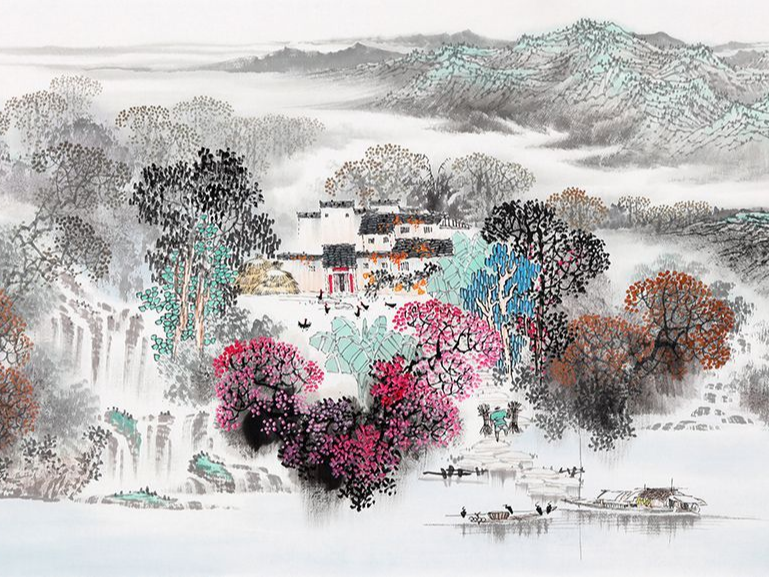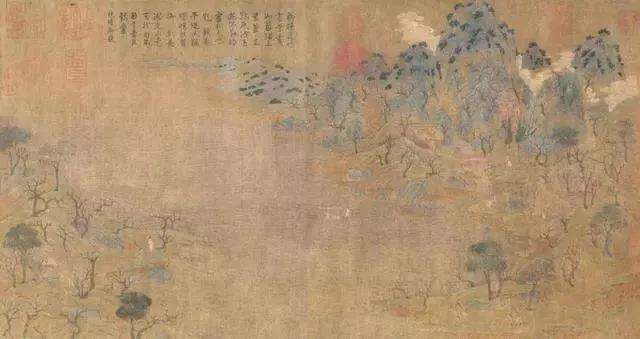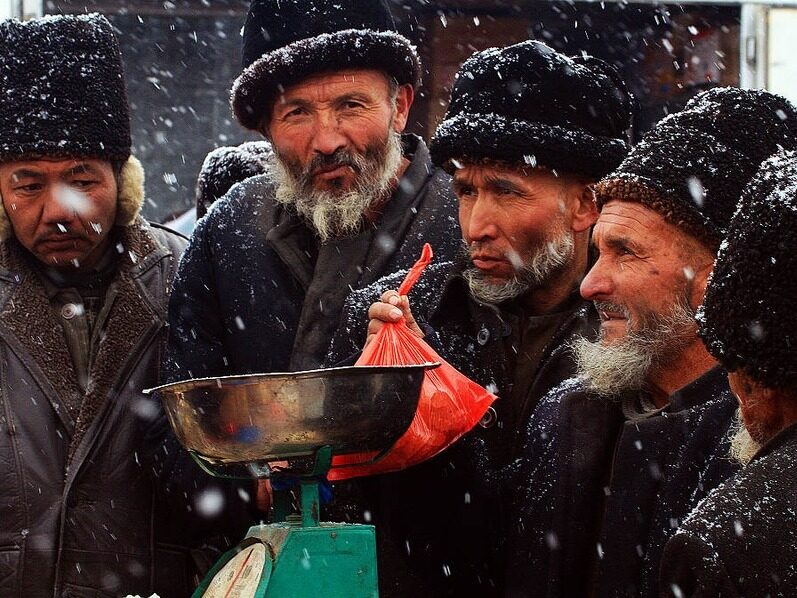- Understanding and mastering some terms of Chinese painting will help us better appreciate the beauty of Chinese painting

The word Chinese painting originated in the Han Dynasty. The Han Dynasty people believed that China is a place among the heavens and the earth, so it is called China. The Chinese painting is called "Chinese painting", or "Chinese painting".

In Chinese painting, some words appear frequently, and understanding and mastering these terms helps us to better appreciate the beauty of Chinese painting.
Sakamoto
Hey, reading four in Chinese painting is often misunderstood. The paintings and paintings on the enamel, enamel and silk fabrics are called transcripts, and the obvious horizontal and vertical textile traces can be seen in the picture.

The masterpiece is the "Xishan Travel Map" of Fan Kuan in the Northern Song Dynasty. Different from transcripts, paper is the most commonly used material in Chinese painting. Based on paper, what is drawn is called paper.
Color setting
The term “coloring” is often used in conjunction with “Sakamoto” and “paper” to appear in the basic information display of Chinese painting.

Coloring is the meaning of smudged color in Chinese painting. As long as color appears in the picture, it can be said to be a coloring work. The opposite of the coloring is "ink", which refers to the work that does not appear in the picture, or which rarely appears in color, and is mainly drawn in ink.
Figure painting
Character painting is a general term for paintings with the character image as the main body. Chinese figure paintings appear earlier than landscape paintings and flower and bird paintings. They are roughly divided into Taoist paintings, ladies paintings, portrait paintings, genre paintings, and historical story paintings. In order to facilitate understanding, we compare the development of figure painting with human life and figure out a development context.

Neolithic Age: The birth of new life. Mainly based on the dance pattern basin. In the Warring States Period: Baby was born, represented by the earliest figure painting "Character Dragon and Phoenix"; Wei Jin Southern and Northern Dynasties: The child's personality development period, represented by the "Luo Shen Fu Tu" in the Eastern Jin Dynasty; the Tang and Five Dynasties: successful career Mature man, the peak period of figure painting, represented by the "Han Xi Zai Night Banquet" of Gu Tangzhong in the Southern Tang Dynasty; Song Dynasty: Retired people, this period pays attention to the landscape of flowers and birds, and the characters often act as the point of view in the mountains; : The elderly who are sick, the landscape paintings of this period have developed very well, the importance of figure paintings has continued to decline; the Ming and Qing Dynasties: found their own hobbies in their later years, the more lively and wonderful people, the figure paintings of this period The styles are more and more diverse, and the combination of Chinese and Western styles is also very exciting. For example, the Qing Dynasty’s cold-blooded "Spring Breathing Reading Map".
Taoist painting
Taoist paintings are often misunderstood as Taoist paintings, but in fact they are paintings based on Taoism and Buddhism (disclosure is another name for Buddhism in China). It includes not only people, but also high morals, gods and ghosts.

Gu Yuzhi, Zhanzi Yi, Wu Daozi, Jin Nong, and Zhang Daqian are masters of painting on the theme of Taoism. The masterpiece of the Taoist paintings is the first of the eight blame of Yangzhou in the middle of the Qing Dynasty.
Beauty portrait
Ladies' paintings are a kind of figure painting, and some can also be written as "female paintings."

Originally referred to as Chinese paintings in the feudal society, the upper class scholars and women's lives. Later, in the figure painting section, it refers to a sub-heading that depicts the life of the upper-level women. Up to now, the concept has been broadened to refer to all female-themed Chinese paintings. The masterpiece is Zhang Wei’s "The Lady of the Country".
landscape painting
Landscape painting is a kind of Chinese painting, with paintings depicting the natural scenery of mountains and rivers. Landscape paintings have gradually developed in the Wei and Jin Dynasties and the Northern and Southern Dynasties, but they are still attached to figure paintings, mainly as backgrounds. The Sui and Tang Dynasties began to be independent, forming a true landscape painting. The earliest remains are "You Chun Tu", followed by Li Sixun's Jinbi landscape, Wang Wei's ink landscape, Wang Qi's splashing landscape.

The Five Dynasties and the Northern Song Dynasty landscape paintings were flourishing, with authors such as Jing Hao, Guan Tong, Li Cheng, Dong Yuan, Ju Ran, Fan Kuan, Xu Daoning, Yan Wengui, Song Di, Wang Wei, Mi Fu, Mi Youren's ink landscape, and The green mountains and rivers of Wang Ximeng, Zhao Bozhen and Zhao Bozhen, and the North and South Jinghui, reached their peak, and have since become a major painting in Chinese painting.

The landscape paintings of the Yuan Dynasty tend to be freehand, with a virtual reality, focusing on the pen and ink, and opening up new styles; the Ming and Qing Dynasties and the modern times have continued to develop and have a new look. Performance is to pay attention to business location and expression of artistic conception. The traditional method is in the form of ink, green, gold, no bone, shallow, light color.
Green mountains and rivers
Green and green landscape is a kind of landscape painting, mainly using mineral stone green and stone green as the main color. Chinese landscape paintings are first colored, followed by ink.

Therefore, the green mountains and rivers appear earlier than the ink landscapes.
Jinbi Mountain Water
It is customary for us to use landscape paintings with mud gold, stone blue and stone green as the main color pigments, called "Jinbi Mountain Water". The Jinbi Mountains are the most brilliant of the green mountains and rivers.

The earliest landscape paintings of the world are the "You Chun Tu" of the exhibition. It is a green landscape and a golden landscape. In modern times, there is also Zhang Daqian’s "Huashan Yunhai Map" that everyone is familiar with.
Folding
Folding is a kind of flower painting. The flower is not written in the whole plant, only the part of the flower branch that has been folded down from the trunk is drawn, hence the name.

Although the Song and Yuan Dynasties have already composed the composition of the branches in the flower and bird paintings, they are popular in the Ming and Qing Dynasties. Small-scale flower paintings such as fan pages often use simple branches to manage composition, and they are very elegant. The masterpiece is the "Spring Breathing Reading Map" of the Qing Dynasty court painter.
Boundary
The paintings are common in the modern and modern court works of the Ming and Qing Dynasties. They refer to paintings based on buildings such as palaces, buildings, and buildings.

The boundary painting is the "boundary", which refers to the painting method of drawing with a straight ruler. The buildings in the boundary paintings can be straight and very regular. The masterpiece is the "Han Yuan Map" by Li Rongzhen of the Yuan Dynasty.
Meticulous and freehand
The meticulous brush is a term of knowledge that has a very high rate of appearance in Chinese painting appreciation. “Meticulous” and “freehand” are the names of Chinese painting techniques. The meticulous brushwork is a kind of dignified painting method.

The courtyard paintings of the Song Dynasty, such as the famous "Ruihetu" of the Huizong of the Northern Song Dynasty, the characters of the Qiu Ying of the Ming Dynasty, and the flower and bird beasts of the Qing Dynasty are worth a reward.

Freehand is to focus on the imagery of the image through a concise and general brushstroke. Such as the Southern Song Dynasty Liang Shu, Fa Chang, Ming Dynasty Chen Yu, Xu Wei, the early Qing Zhu Xi, etc., good at freehand brushwork. If you understand the freehand brushwork, you can find Qi Baishi's works. Some of his works have both freehand brushwork and meticulous work. For example, in the grassworm album, the grass worms are usually meticulous, and the flowers and plants around the grass worms are basically freehand.
No bone
No bones, but also a name classified according to the technique of painting. The style is fine and mostly colored.

But the difference from the meticulous work is that no bones are used for the bones, and the objects are directly painted in color, so it gets its name.
Powder
The manuscript of the ancient Chinese paintings applied in powder, in other words, is the "small draft."

Before drawing a large oil painting with the West, it is necessary to draw a sketch and look at the approximate effect.
Piece
Different from the stage performances on the stage, "small products" have specific meanings in Chinese paintings. They refer to the works of Chinese painters who are more free and lyrical. They are free to do so, and there is not too much restraint in their thinking. Often the artistic level reaches a higher level. The size is generally small, with the characteristics of small and medium-sized, and always alert.

Among the essays, the most representative one is the Song Dynasty essay painting, which is the epitome of the Song Dynasty painting art. Some of these pieces may have been decorative paintings arranged on the screen in the palace, or decorative paintings painted on the fan. Because of their high artistic quality, they were collected and assembled. Representing Ma Yuan's "Meishi Creek Map", one of the four members of the Southern Song Dynasty.
Knowledge
These two words will definitely be used in the paintings of ancient paintings. The money in the book and painting, also known as the "question" or "section", refers to the words, seals, and even flowers that are inscribed outside the body of the paintings, such as Song Huizong's "Tianxia people". The text content is usually the name, time, and location.

The seal of "Poetry, Painting, and Printing is not separated from home" is also reflected in the form of paintings and paintings. Since the Yuan, Ming and Qing dynasties, the painters have paid more and more attention to the role of the funds, and deliberately pursued the artistic effect of the money, so there is a saying that "the word is worth a thousand flowers."
Although the picture and the text are the main body of the paintings and paintings, which determine the pros and cons of the works, the quality of the works, especially the texts written by the department (in addition to the text), will obviously affect the artistic effect of the whole article. A counterexample is Tang Shuben, Wang Xizhi's "Quick Snow Spring Post", which was covered with dozens of chapters by the Qianlong Emperor.
Cao Yi’s water and Wu belt
"Cao Yi water" is a concept opposite to "Wu belt wind", mainly refers to two different expressions of clothes pleats in ancient figures.

The former's brushwork is very thick, and the figure of the figure is close to the body, just like the one just coming out of the water; the latter's brushwork is round and elegant, and the painted figure is like a wind fluttering.
Spring silkworm silk
Spring silkworm silk is used to describe the characteristics of line drawing figure painting. The ancients called Gu Yuzhi's line drawing, just like "spring silkworm silking." Can draw a soft, soft, unobstructed visual effect. In the description, it is the most different from the "spring silkworm silk", but it is also widely used in the "iron wire drawing". "Iron wire drawing" is very resolute.

The above picture of "Yongle Palace murals" includes "spring silkworm silking" and "iron wire drawing". The two feel different, you can try to find it.
Ink five points
"Ink and five points" is often used in the study of ink works, the language of the Tang Dynasty Zhang Yanyuan "historical paintings": "Ink and five colors." For example, the ink landscape is made up of different proportions of water and ink, and there are different gray and black changes. It is a multi-layered dry and wet.

What are the five colors of "five colors"? The sayings are different. Most of them are: coke, thick, heavy, light, and clear; others think it should be said: thick, light, dry, wet, black; also add "white", collectively called "six colors." In fact, it refers to the rich changes in the use of ink. It is not necessary to be too mechanical to understand. Do not think that ink and water can only be called up to five changes. In fact, the change should be more. The representative works such as the Qing Dynasty seclusion map of Wang Meng.
Three far
"Three Fars" is a word that can hardly escape when you enjoy landscape painting. In the "Lin Quan Gao Zhi" of the Northern Song Dynasty, Guo Sizheng recorded the three fares of his father Guo Xi: Gao Yuan, Ping Yuan, and Yuan Yuan. From the bottom of the mountain to the top of the mountain, it is said to be high; from the front of the mountain and peek into the mountains, it is far-reaching; from the mountains and the mountains, it is far-reaching.

Gao Yuan is what I am talking about now; Ping Yuan is what I am talking about now; far-reaching is what I am talking about now, plus look.
Leave blank
The white space is a commonly used technique in the creation of Chinese art works, and it has Chinese aesthetic characteristics.

The white space refers to the artistic creation of painting and calligraphy. In order to make the whole work picture and chapter method more harmonious and beautiful, it intends to leave a corresponding blank. Some are for the sake of snow, moon, etc.; some are for the imagination of the audience. Editor / Zhao Jing
Comment
 Praise
Praise
 Collect
Collect
 Comment
Comment
 Search
Search














Write something~